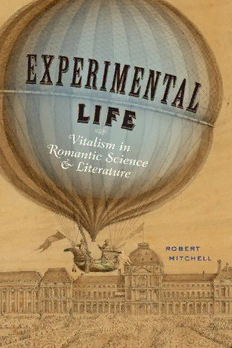
Experimental Life: Vitalism in Romantic Science and Literature PDF
Preview Experimental Life: Vitalism in Romantic Science and Literature
Experimental Life This page intentionally left blank Experimental Life Vitalism in Romantic Science and Literature Robert Mitchell Johns Hopkins University Press Baltimore © 2013 Johns Hopkins University Press All rights reserved. Published 2013 Printed in the United States of America on acid-free paper 2 4 6 8 9 7 5 3 1 Johns Hopkins University Press 2715 North Charles Street Baltimore, Maryland 21218-4363 www.press.jhu.edu Library of Congress Cataloging-in-Publication Data Mitchell, Robert, 1969– Experimental life : vitalism in Romantic science and literature / Robert Mitchell. pages cm. Includes bibliographical references and index. ISBN 978-1-4214-1088-3 (hardcover : acid-free paper) — ISBN 978-1-4214-1089-0 (electronic) — ISBN 1-4214-1088-5 (hardcover : acid-free paper) — ISBN 1-4214-1089-3 (electronic) 1. English literature—19th century—History and criticism. 2. Literature and science—England—History—19th century. 3. Romanticism— England. 4. Vitalism in literature. 5. Life in literature. I. Title. PR585.S33M58 2013 820.9(cid:2)36—dc23 2013004819 A catalog record for this book is available from the British Library. Special discounts are available for bulk purchases of this book. For more information, please contact Special Sales at 410-516-6936 or [email protected]. Johns Hopkins University Press uses environmentally friendly book materials, including recycled text paper that is composed of at least 30 percent post-consumer waste, whenever possible. Contents Acknowledgments vii Introduction Three Eras of Experimental Vitalism 1 1 Romanticism, Art, and Experiments 14 2 Suspended Animation and the Poetics of Trance 43 3 Life, Orientation, and Abandoned Experiments 74 4 Nausea, Digestion, and the Collapsurgence of System 104 5 The Media of Life 144 6 Cryptogamia 190 Conclusion Biopolitics and Experimental Vitalism 218 Notes 231 Bibliography 271 Index 295 This page intentionally left blank Acknowledgments This book is the result of the intersection of two lines of research I initially thought of as quite separate. It had its origins in research that I conducted for Sympathy and the State in the Romantic Era (2007). That book focused on eighteenth- and nineteenth-century theories of sympathy, a term that then referred not only to moral relationships among individuals but also to a physiological action-at-a- distance that occurred within a living body. Although I was not able to include discussion of the latter, medical sense of sympathy in that earlier project, my research on this topic put me on the path of those Romantic concepts of life that are the focus of this book. The book is also the result of a quite different line of research, one focused on the cultural logic and economics of our own, contemporary systems of biological research and healthcare. Relatively little of my work in this area has engaged lit- erature, and I have focused primarily on technologies and techniques developed since the 1970s (e.g., genetic engineering, organ transplantation, and biobank- ing). Yet with some degree of regularity, peculiar resonances emerged between my literary critical work on the Romantic era and my more sociological work on contemporary biotechnology. I became fascinated, for example, with the final stages of the process by means of which contemporary biologists create immortal cell lines, as cells were lowered into waist-high cylindrical liquid nitrogen tanks to be frozen. I saw these cylinders as urns that quite literally produced what Keats had called frozen time, as the liquid nitrogen suspended the living processes of this matter so that the biologist could return to these same cells later, as though no time at all had passed for the cells. When, at about the same time, I read John Hunter’s late-eighteenth-century reflections on the newly coined term “sus- pended animation,” and reflected on his hopes that suspended animation might allow for a new kind of human existence and a new mode of scientific observa- tion, I became convinced that it was worth pursuing further these resonances between the Romantic era and the present—and this volume is the result of that viii acknowledgments endeavor (though early versions of chapters 2 and 6 appeared in PMLA and Eu- ropean Romantic Review, respectively). Because this project has been under way for a relatively long time, and be- cause I have pursued its concepts, questions, and problems across several research communities, I have been assisted by a quite considerable list of people, and I es- pecially wish to thank the following: Lindsey Andrews; Alan Bewell; James Bono; Andrew Burkett; David Clark (to whom I owe the phrase “experimenting with experimentation”); Matthew Cohen; David Collings; Allison Dushane; Michael Eberle-Sinatra and the members of the Technologies, Media, and Representa- tions in Nineteenth-Century France and England Research Group; Tim Fulford; Denise Gigante and the members of the Seminar on Enlightenment and Revo- lution; Nick Halmi; Orit Halpern; Tim Lenoir; Tracie Matysik, Sam Baker, and Phillipa Levine and the members of the Nineteenth-Century Workshop; Sean Metzger; Colin Milburn; Thomas Pfau; Michelle Puetz; Phillip Thurtle; Charles Rzepka; Alexander Schlutz; Barbara Herrnstein Smith; Alan Vardy; Priscilla Wald; and Nancy Yousef. I also wish to thank Colleen M. Weum and Cheyenne Maria Roduin for assis- tance with textual resources in the Health Sciences Rare Book Room at the Uni- versity of Washington; Duke University’s Arts and Sciences Research Council, which provided vital financial support for this project at various points; and the National Humanities Center and the Duke Endowment Fellowship, which made it possible for me to complete the manuscript of the book in the Center’s convivial surroundings. I am also grateful to Meghan O’Neil, Chris Catanese, and Glenn Perkins for their able proofreading assistance, and to Matthew McAdam, my edi- tor at the Johns Hopkins University Press, with whom it was a joy to work. And last, but definitely not least, my heartfelt thanks go to Inga Pollmann, who not only patiently read and commented on many drafts of each of these chapters, and whose work on the life of film has been an inspiration for my own project here, but who has, in addition, always been a vitalizing pneuma for me. Experimental Life
